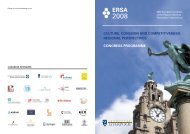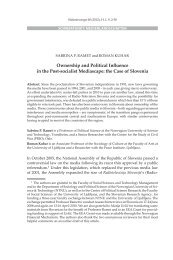The Scientific and Humane Legacy of Max Perutz - Molecular ...
The Scientific and Humane Legacy of Max Perutz - Molecular ...
The Scientific and Humane Legacy of Max Perutz - Molecular ...
Create successful ePaper yourself
Turn your PDF publications into a flip-book with our unique Google optimized e-Paper software.
ESSAY<br />
attached at a specific position on each protein molecule in a<br />
crystal, it would produce a measurable change in the<br />
intensities <strong>of</strong> the reflections (diffraction spots), <strong>and</strong> this<br />
could be used to obtain (X-ray) phase information necessary<br />
for the determination <strong>of</strong> the structure (the imaging) <strong>of</strong> the<br />
haemoglobin molecule. His peers <strong>and</strong> contemporaries had<br />
wrongly assumed that any such change (to the intensities <strong>of</strong><br />
X-ray patterns) would be immeasurably small; but <strong>Perutz</strong><br />
did the experiment carefully, using haemoglobin labelled<br />
with mercury, <strong>and</strong> he found quite measurable changes∫.<br />
This constituted a major breakthrough in the methodological<br />
approachto the structure <strong>of</strong> proteins. [16] When the world×s<br />
experts on proteins, assembled by Pauling at the California<br />
Institute <strong>of</strong> Technology in September 1953 (Figure 3), heard<br />
<strong>Perutz</strong> adumbrate his method, they were conscious that a<br />
major breakthrough in protein science was imminent. <strong>Perutz</strong><br />
later wrote:<br />
As I developed my first X-ray photograph <strong>of</strong> mercury<br />
haemoglobin my mood altered between sanguine hopes <strong>of</strong><br />
immediate success <strong>and</strong> desperate forebodings <strong>of</strong> all possible<br />
causes <strong>of</strong> failure. I was jubilant when the diffraction spots<br />
appeared in exactly the same positions as in the mercury-free<br />
protein, but with slightly altered intensity, exactly as I had<br />
hoped∫.<br />
Figure 3. Group photograph taken at the Pasadena Conference on the Structure <strong>of</strong> Proteins in California,<br />
organized by Linus Pauling, 21 ± 25 September 1953.<br />
For <strong>Perutz</strong> <strong>and</strong> Kendrew (who also adopted the heavy-atom<br />
approach to the determination <strong>of</strong> the structure <strong>of</strong> myoglobin),<br />
great difficulties still lay ahead before the new method could<br />
lead to an interpretable structure. [13, 17] First, it was necessary<br />
to have several different heavy-atom derivatives before the<br />
phases <strong>of</strong> all the reflections could be reliably assigned.<br />
Second, all these derivatives had to crystallize with exactly<br />
the same (unit cell) dimensions. Third, appropriate mathematical<br />
procedures had to be devised for calculating the<br />
phases. Numerous assistants had to make intensity comparisons<br />
(using relatively primitive microdensitometers) on<br />
hundreds <strong>of</strong> thous<strong>and</strong>s <strong>of</strong> diffraction spots; <strong>and</strong>, in turn, the<br />
electron-density distributions had to be calculated on very<br />
early–<strong>and</strong> by present-day st<strong>and</strong>ards extremely primitive–<br />
computers in the University <strong>of</strong> Cambridge Mathematics<br />
Department.<br />
Kendrew, assisted by two visiting American scientists<br />
(Dickerson <strong>and</strong> Dintzis) who came to the <strong>Perutz</strong> ± Kendrew<br />
unit in the Cavendish Laboratory succeeded in obtaining<br />
crystals <strong>of</strong> gold- <strong>and</strong> palladium-substituted myoglobin. With<br />
their resulting X-ray diffraction patterns, Kendrew, who<br />
possessed formidable quantitative skills <strong>and</strong> who took advantage<br />
<strong>of</strong> the emergence in Cambridge <strong>of</strong> the EDSAC-1 <strong>and</strong><br />
EDSAC-2 (programable) digital computers, which he exploited<br />
for the Fourier analysis <strong>of</strong> his diffraction data, solved the<br />
structure <strong>of</strong> myoglobin in 1957. [19] But within two years, <strong>Perutz</strong>,<br />
along withhis MRC associates<br />
Ann Cullis, Hilary Muirhead,<br />
Michael Rossmann, <strong>and</strong><br />
Tony North, had unraveled the<br />
architecture <strong>of</strong> the haemoglobin<br />
molecule, which contains four<br />
times as many non-hydrogen<br />
atoms (10 000) as myoglobin. [20]<br />
Here were two quite independent<br />
structural determinations<br />
<strong>of</strong> related proteins, done<br />
by pure physics, without any<br />
assumptions about the chemical<br />
nature <strong>of</strong> haemoglobin <strong>and</strong> myoglobin<br />
or the relation between<br />
them. This exhilarating information<br />
revealed that the intrinsic<br />
structures <strong>of</strong> the two proteins,<br />
replete withhaem groups, numerous<br />
folds, <strong>and</strong> (Pauling×s) a-<br />
helices, were essentially similar.<br />
<strong>The</strong> inescapable conclusion was<br />
that each had to be right. This<br />
galvanized activity in molecular<br />
biology worldwide. Adolf Buten<strong>and</strong>t,<br />
the eminent German Nobel<br />
Laureate, set his colleagues<br />
in Munichthe task <strong>of</strong> using<br />
chemical methods (such as those<br />
pioneered by Frederick Sanger)<br />
to trace the sequence <strong>of</strong> amino<br />
acids in the proteins studied by<br />
<strong>Perutz</strong> <strong>and</strong> Kendrew. <strong>The</strong> chem-<br />
3158 ¹ 2002 WILEY-VCH Verlag GmbH & Co. KGaA, Weinheim 1433-7851/02/4117-3158 $ 20.00+.50/0 Angew. Chem. Int. Ed. 2002, 41, No.17





